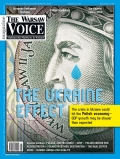

The Warsaw Voice | 16 kwiecień 2008

* Pokazana okładka tytułu jest aktualną okładką tytułu The Warsaw Voice. Kiosk24.pl nie gwarantuje, że czytany artykuł pochodzi z numeru, którego okładka jest prezentowana.
The continued appreciation of the Polish currency makes consumers happy, but at the same time it means trouble for exporters because a stronger zloty is hurting the profitability and competitiveness of Polish products on markets abroad.
In early April, the zloty traded at less than 3.50 to the euro, in what was the Polish currency’s highest level in seven years. The zloty also hit some new highs against the dollar, trading at less than 2.20. Experts say the Polish currency is bound to grow even stronger and any hopes that the euro and the dollar will regain ground any time soon are in vain. The main driving force behind the zloty’s appreciation is the good performance of the Polish economy coupled with what happens on international markets. Like other countries in the region, Poland is frequently perceived as an attractive alternative to highly developed countries. In times of uncertainty on global markets, investors are particularly keen to search for rapidly developing countries that often prove to be better destinations for investment. Data published in March confirmed that Poland was one such country. Industrial production grew by 14.9 percent in February, and retail sales skyrocketed by 23.8 percent. Other factors that stimulate inflation include a steady improvement on the labor market that has continued for months. Unemployment dropped from 11.7 percent in January to 11.5 percent in February. Official forecasts put this year’s GDP growth at 5.5 percent. To keep inflation in check, the Monetary Policy Council (RPP) has increased interest rates. The prime lending rate currently stands at 5.75 percent and is likely to climb to 6 percent in April or May. Higher returns on investment in zloty assets strengthen the Polish currency and make it more attractive to financial investors. Apart from macroeconomic factors, the zloty is appreciating as a result of money transfers from Polish citizens working abroad. The National Bank of Poland estimates that these transfers exceeded zl.20 billion last year, which was double their 2004 level. It seems, however, that the zloty’s further appreciation against the pound sterling and the euro will curb the influx of expat funds. On the one hand, the appreciation of the Polish currency is benefiting consumers at home, as it leads to lower foreign debt service costs, cheaper fuel and lower prices of various imported goods. On the other hand, a strong zloty means considerable problems for exporters who are earning less money for their goods in zloty terms. This has prompted the Association of Polish Exporters to come up with an appeal to the prime minister, the finance minister and the central bank governor to take action. “The current situation causes export-oriented production to shrink, as a result of which Polish enterprises are losing their status as important partners in trade, a status they have earned through their hard work over the years,” the appeal reads. The association has called for a policy to strengthen exports by allowing sustainable economic growth and guaranteeing more competitive exports. “The current state of affairs shows no signs of improvement, as evidenced by the decelerating growth of exports in 2007 and the first quarter of 2008,” the association wrote. “As a result, exports have lost their momentum as a major driver of GDP growth. It is necessary to create clear, stable and predictable conditions for exports in order to develop, modernize and improve the competitiveness of the Polish economy, with a special focus on the labor market. We need rational policies on interest rates and interest on Treasury bonds and certificates, along with measures to decrease the budget deficit by financing it with Treasury securities. Also needed is a higher foreign reserve at the central bank and Poland’s swift entry to the eurozone.” Businesses affiliated in the Polish Chamber of Commerce are also concerned with the worsening profitability of exporters. “The government should address the negative mood in the corporate sector that results from the situation on the foreign exchange market,” said Andrzej Arendarski, president of the Polish Chamber of Commerce. “Polish companies, especially exporters and producers who compete with cheap imports from Asia, want the euro conversion to take place as soon as possible.” So far, however, Poland’s foreign trade statistics have not confirmed exporters’ fears, and exports continue to be one of the key driving forces of the Polish economy. In 2007, Polish companies shipped abroad over 101 billion euros worth of goods, and it seems that this year should not be much worse than that. The latest forecasts by the central bank indicate that Poland’s foreign trade will continue to grow at a fast rate. Central bank experts say that neither the appreciating zloty nor the latest economic slowdown in the eurozone and the United States are likely to affect the rapid growth of exports in any significant way. Both this year and next, Poland’s exports are expected to grow 9.5 percent annually, followed by 9.9 percent in 2010.
Andrzej Ratajczyk
 Wróć do czytelni
Wróć do czytelni